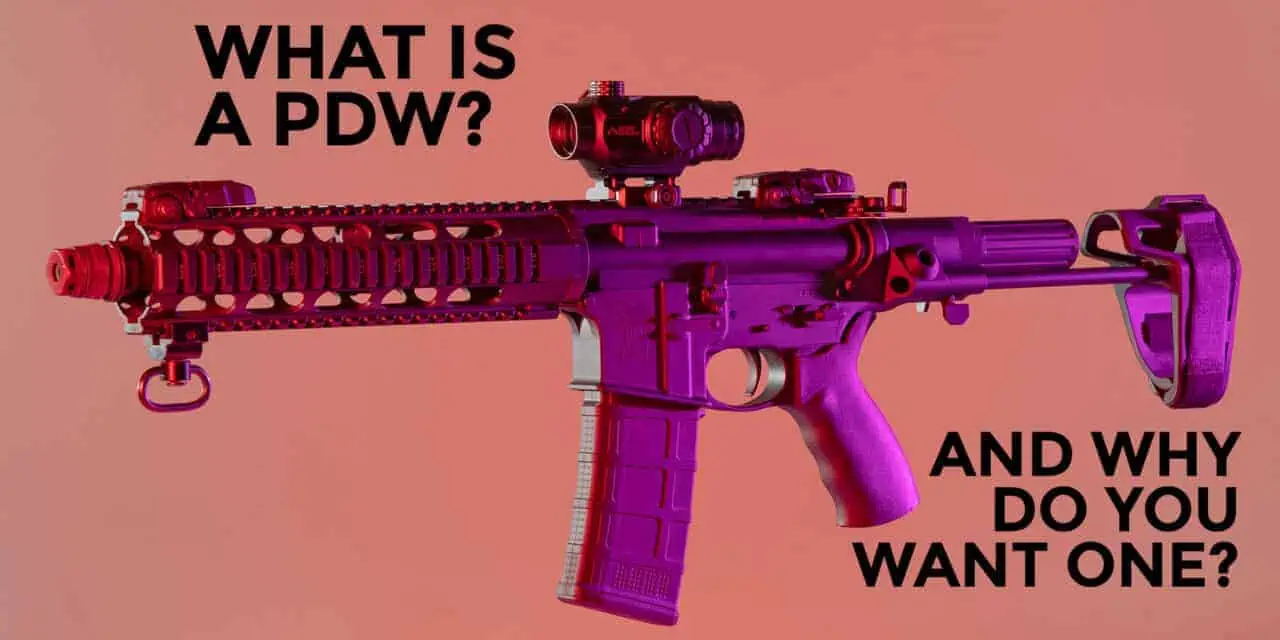More Than A Pistol, Less Than A Rifle: A Look At The PDW Gun
All gun owners have favorite guns. For some, it’s the venerable M1 Garand. For others, it’s the 1911 pistol. Others like revolvers of all shapes and sizes and so on. For me, it’s CZ pistols, designated marksman rifles and PDW guns. So, let’s talk about PDWs, or the Personal Defense Weapon.
What is a PDW?
A PDW is meant to be a defensive firearm that is more effective at longer ranges than a pistol, but weighs less and takes up less space than a rifle or other long gun. They typically use a cartridge that is more powerful than a pistol cartridge but has less punch and lower recoil than a full-sized rifle cartridge.
PDWs are not meant to be carried by front-line troops who engage the enemy on a regular basis. Rather, they are intended for rear-echelon troops such as drivers and other support personnel who rarely see contact with the enemy, but still need something more than a handgun to defend themselves. There is an exception to the idea of a PDW being a rear-echelon weapon, but we’ll get to that later. Lastly, a PDW is meant to be carried in situations where carrying a full-sized rifle is impractical or unwieldy, such as inside an armored fighting vehicle or while firing artillery, to name two uses.
The idea behind a PDW gun has been around almost as long as semi-automatic pistols have been around. One of the first semi-auto pistols, the Mauser C96, shipped with a wooden holster that was meant to be used as a shoulder stock. When the pistol is attached to the stock, it becomes more accurate than just the pistol by itself, allowing a shooter to engage targets out to 50 yards and beyond.
The National Firearms Act Brings Down The Curtain
Another German pistol, the P-08 Luger was available with holsters that could double as a stock, as was the Belgian-made FN Hi Power and other guns. Something happened, though, that reduced the popularity of using a pistol with a stock as a PDW gun. In 1934, the National Firearms Act became the law of the land in the United States. The NFA required a $200 tax and a background check to own a short-barreled gun like the aforementioned pistols, as well as any rifled gun with a stock and a barrel length of less than 16 inches. While this had no effect on the military’s use of PDW guns, it quickly reduced the demand for PDWs for armed citizens in the U.S.
The second reason for the decline of the PDW is the appearance of several new and very effective models of submachine guns all over the world. Compact, fully automatic firearms like the British Sten and German MP40 were small enough to be carried easily, yet had tremendous short-range firepower. The American military saw a need for a compact gun for second-line troops, and the M1 Carbine was born. The small size of the M1 made it an attractive option for paratroopers, headquarters staff and similar troops, and it continues to be in high demand for the armed citizens of today.
Everything Old Is New Again
The M1 Carbine was replaced in American service by the M-16 rifle. The light weight and small size of the M-16 was meant to be a “one size fits all” solution that would replace the M-14 battle rifle, the M1 carbine and the M3 submachine gun. However, like most all-in-one solutions, there were some exceptions to the idea that the M-16 could serve many roles.
American paratroopers in WWII realized the usefulness of a small, easy to maneuver gun and adapted the M1 Carbine for front-line use. The troops in today’s elite military units also saw a need for a very compact gun that brought more to the party than just a pistol, but didn’t have the weight and bulk of even a smaller-sized gun like the M-16, and the modern PDW was born. Two firearms in particular epitomize the modern PDW gun. The first is the Heckler & Koch M97A1, which shoots a 4.7x30mm cartridge, and the FN P90, which shoots 5.7x28mm. The MP7A1 has not been offered to armed citizens. However, a version of the P90 has, along with two different pistols chambered for the 5.7mm cartridge.
The Rebirth Of The Civilian PDW Gun
A third type of military PDW has arisen, the short-barrelled rifle based on the M-16’s successor, the M-4 carbine. These guns are even smaller than either the M-16 or the M-4 and use folding stocks to reduce their size even further. Innovations in ammunition like the 300 Blackout cartridge mean that an AR-15 style gun (the semi-automatic cousin of the fully automatic M4 and M16) can have a short barrel for maximum portability and still be accurate out to 200 yards and beyond. The Honey Badger from Q and similar guns are examples of this brand of PDW that is growing in popularity with the military, law enforcement and also for armed citizens.

The addition of a red dot sight and a collapsible brace can extend the effective range of a pistol out to 50 meters and beyond.
The National Firearms Act may have put the brakes on PDW ownership by armed citizens here in the U.S., but time and technology marches on. In 2014, SB Tactical created a brace which attached to an AR-15 buffer tube. The brace was not meant to be used as a stock, but rather stabilized the pistol when used with one hand. The Bureau of Alcohol, Tobacco and Firearms (ATF for short) first ruled that a brace is not a stock and therefore could be used on a gun with a barrel length less than 16 inches.
Things have gotten a tad confusing with the ATF and their rulings on braces since then, but as of December of 2020, braces are okay to use in any manner you see fit. This may change, though, and consult a lawyer if there’s any doubt in your mind about how to use a pistol brace.
Consider Your Options Before Buying A PDW Gun
Despite all this confusion, pistol braces have become a popular way for armed citizens to enter the world of PDW guns. A PDW makes sense for the private gun owner for the same reasons they make sense for the military and other agencies. They’re smaller than a rifle, which means they are easier to use inside of a home. That small size also means they are an excellent choice if you’re travelling but want something more with you than just your defensive pistol. Lastly, civilian PDWs, especially those in pistol calibers, have very light recoil and are very easy to control.
Whether or not you should own a personal defense weapon depends a lot on you and your lifestyle. In my case, my family and I take regular vacations and I also travel a fair amount for business. I like the idea of having something more than just my defensive pistol with me in the hotel room or when I’m on the road, and a PDW that’s based on a pistol brace fills that role nicely. I chose the folding brace from Recover Tactical, along with a mag holder that fits on the front of the brace and a Streamlight TLR-7 as a weapon light.
This setup mimics the Glock 19 I use for daily carry, but it’s small enough to carry in a laptop bag or messenger bag, which means I don’t have to leave it in my vehicle if I’m out and about. The red dot sight on the gun, along with the brace, makes it easy to engage targets out to 100 yards and also perform fast, accurate followup shots on targets at shorter ranges.
Small Guns, Big Punch, Many Options
A Personal Defense Weapon has some downsides. A PDW lacks the man-stopping punch of a full-sized rifle round due to it’s lower-powered cartridge. This in turns limits their useful range and also means that multiple hits are probably going to be needed to stop a threat. A PDW is small, but is it still going to need some sort of off-body carry in a civilian context, and this brings in a host of other problems. Finally, because they are larger and bulkier than a defensive pistol, they will be slower on the draw than a defensive pistol. All of this means that a PDW gun shouldn’t be your first choice for an everyday carry defensive firearm. However, they may be looking into if you’re in the market for something that is more flexible and capable than your concealed carry pistol.
The wide acceptance of the pistol brace and the re-introduction of smaller guns into military armories has created a renaissance for the PDW gun. The advantages of a gun that provides more punch than a pistol yet doesn’t have the bulk of a rifle are becoming apparent to soldiers and armed citizens alike. If you’re looking for a gun that does more than your defensive pistol and can be near you pretty much everywhere you go, take a good look at some of the modern PDW options out there, and see if one fits your lifestyle.




